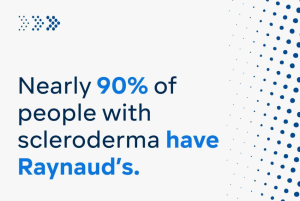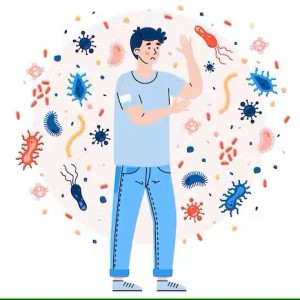 To coincide with Scleroderma Awareness Month and this year’s theme, I’ve been sharing stories from a few people that I’ve come to know over the past few years or so throughout the month.
To coincide with Scleroderma Awareness Month and this year’s theme, I’ve been sharing stories from a few people that I’ve come to know over the past few years or so throughout the month.
Because “Every Journey Matters!”
Each person has expressed different aspects of their scleroderma journey as it is widely recognised that each person’s experience with scleroderma is unique, and no two cases are the same.
So far we have heard from; Diane in Wellington, New Zealand.
Michael (AKA the Sclero Guy) from the United States.
Helen from Tāmaki Makaurau, Aotearoa (Auckland, New Zealand).
I’m sure that you’ve enjoyed reading about how each person got diagnosed, and the different symptoms and treatments that they have gone through and the ongoing challenges that they face.
Today we meet Camille from the United States of America who was diagnosed in 2021. She is a Scleroderma Warrior from Wisconsin who I met while training as a Peer Mentor.
She is extremely passionate about providing support and encouragement to others that have been diagnosed with this rare, incurable disease. She is the Wisconsin lead volunteer for the National Scleroderma Foundation’s Upper Great Lakes Chapter and has helped develop the Peer Mentor Plus Program and the monthly Lunch & Learn Program.
She writes; In the fall of 2020, I began experiencing scary health symptoms including shortness of breath, Raynaud’s episodes in my hands, and extreme fatigue. By the end of that year, I had developed numerous ulcerative wounds on my fingers. My face, hands, and feet had become extremely swollen. And I had intense nerve pain in my hands.
By the beginning of 2021, my symptoms had progressed so rapidly and severely that my husband Denny and I decided to travel to the Mayo Clinic for a second opinion and treatment options.
 It was a terrifying time and I’ll never forget my meeting with the Rheumatologist when she told me; “you have Scleroderma. It’s a progressive disease, but we don’t have a way to predict how it will progress for you.
It was a terrifying time and I’ll never forget my meeting with the Rheumatologist when she told me; “you have Scleroderma. It’s a progressive disease, but we don’t have a way to predict how it will progress for you.
And there is no cure.”
Scleroderma is a rare autoimmune and rheumatic disease affecting approximately 300,000 Americans. It causes the connective tissue in the body to tighten and harden. This in turn can cause vascular degeneration, tightening and thickening of the skin, chronic pain, joint stiffness, muscle weakness, mobility issues and fatigue.
It can also cause fibrosis and damage to internal organs, including the lungs, heart, kidneys, and gastrointestinal systems. Although not very well known, Scleroderma is the deadliest of all rheumatic diseases.
The tricky part about Scleroderma is that no two patients are alike and therefore, it’s impossible to draw homogenous patterns and create treatment plans across the patient population. This makes it very difficult to identify, diagnose and find effective treatments for patients.
If you didn’t know me before I got sick, you’d probably not be able to tell that anything was wrong. That’s because Scleroderma is known as an “invisible illness”, because often the symptoms are not visible from the outside. So, the internal havoc it’s wreaking isn’t readily apparent.
During the height of progressive activity, my heart, pulmonary pressures, musculoskeletal system, and kidneys were severely impacted.

Today, my doctor likes to say that I’m “stable” given my history. However, we are still challenged to find sustainable treatment options to control my symptoms.
Prior to my diagnosis, I had never heard of Scleroderma, but now three short years later, it has turned my life completely upside down. I became disabled and had to leave my successful 25+ year career in Human Resources.
Once an avid exerciser who loved to walk and adventure; my mobility has deteriorated so that I now require the use of a cane, walker or motorized wheelchair depending on the distance.
I have persistent GI issues that prevent me from getting the valuable nutrients I need to maintain a healthy weight. I have severe fatigue and daily pain which limits my activities of daily living.
I was diagnosed just 6 ½ years into my marriage to my amazing husband Denny, and it has significantly impacted our plans and dreams for what we imagined our life would be.
My life as a Scleroderma Warrior is a challenge, but I’ve found it helpful to focus on the things I CAN do and less on what I can’t. The things that Scleroderma hasn’t taken away are my trust in God, my resolve to never give up on myself, or my desire to give back by helping others navigate their Scleroderma journey.

In 2023 I decided that although I have Scleroderma, it wasn’t going to have me.
I began volunteering for the National Scleroderma Foundations Upper Great Lakes Chapter, which covers Wisconsin, Michigan, and Minnesota. I now serve as the Volunteer State Lead for Wisconsin.
I recently started a virtual support group for Wisconsin which I’m very excited about and my goal is to help grow community participation throughout the chapter.
In addition to the support group;
I’m proud to be able to contribute to the creation of our Peer Mentor Plus program and support tools like our Health Management Binder and Choosing Resilience and Hope booklet. I also coordinate virtual community events like our annual holiday cookbook, Bingo night and painting parties, amongst other things.
Camille is certainly an inspiration to many all over America, and the world 🙂 Despite the many up’s and down’s she’s experienced with this disease, she continues to make a difference with her strong attitude of gratitude and her self-awareness of the lessons this disease is teaching her.
She has been willingly sharing these as ‘Wednesday Wisdom’ posts on her personal facebook page each week for over 5 years, and this year I asked her to start posting these on the Help End Scleroderma† page which I co-administer with her and Susan Osten.
This is a Christian page designed to serve Scleroderma patients, in various ways. Most importantly, “Raising Awareness” of Scleroderma, which can be one of the “Greatest Gifts” you can give to those who have Scleroderma.
Supporting and encouraging others is indicative of what the Gospel message is all about. We would also value your prayers for a cure to be found and treatments to be made more readily available.
 Even though Scleroderma Awareness Month is coming to a close for this year, World Scleroderma Day is happening tomorrow (check back to see what this is all about).
Even though Scleroderma Awareness Month is coming to a close for this year, World Scleroderma Day is happening tomorrow (check back to see what this is all about).
So, how can you help raise awareness?
Maybe you could promote this post, Scleroderma New Zealand, or the Help End Scleroderma† page on your social media platform / feed to help get the word out and raise the profile of this rare disease.
Maybe you could contact someone with Scleroderma just for a chat, or offer to take them out for a cuppa, as having this disease can be quite isolating 😦
Possibly you’re in a position to volunteer your time, provide other resources / talents to help others in need, or even contribute financially to one of the Scleroderma foundations or charities in your country.
Here in Aotearoa (New Zealand) you can either drop me a line here or leave a comment below to discuss how you can help out, or you could fundraise / donate through the Scleroderma New Zealand Inc. givealittle page.
Every $ raised contributes towards raising awareness about Scleroderma, and supporting and encouraging those with Scleroderma and their families cope with this rare and difficult disease.
Blessings ’til next time 🙂
 The weather has definitely taken a turn for the worse, in most parts of the country here in Aotearoa (New Zealand) and winter can take a toll on our physical and mental health.
The weather has definitely taken a turn for the worse, in most parts of the country here in Aotearoa (New Zealand) and winter can take a toll on our physical and mental health.

 Also, get the latest flu and COVID-19 vaccines to avoid being sick during the coldest time of year.
Also, get the latest flu and COVID-19 vaccines to avoid being sick during the coldest time of year. “Heavens to Murgatroyd!” was a popular catch phrase that Daws Butler’s animated Hanna-Barbera TV character Snagglepuss often said.
“Heavens to Murgatroyd!” was a popular catch phrase that Daws Butler’s animated Hanna-Barbera TV character Snagglepuss often said. This scar tissue then blocks the very small air sacs called the a
This scar tissue then blocks the very small air sacs called the a So, you could say that I’m being hit by a double, or maybe even a triple whammy 🙂
So, you could say that I’m being hit by a double, or maybe even a triple whammy 🙂
 To coincide with Scleroderma Awareness Month and this year’s theme:
To coincide with Scleroderma Awareness Month and this year’s theme: I wear the
I wear the  This year I had Mohs surgery for two skin cancers on my nose. The cancers had sped up in the previous six months. I had about 6 incision lines and all the appropriate stitches.
This year I had Mohs surgery for two skin cancers on my nose. The cancers had sped up in the previous six months. I had about 6 incision lines and all the appropriate stitches. 
 An article recently appeared on Scleroderma News, shedding some light on one of the many challenges of living with an autoimmune disease, chronic illness, rare disease or disorder, invisible disability etc.
An article recently appeared on Scleroderma News, shedding some light on one of the many challenges of living with an autoimmune disease, chronic illness, rare disease or disorder, invisible disability etc.
 The resilience of the participants was assessed using a self-reported questionnaire designed to evaluate adaptability, self-efficacy (related to self-confidence and one’s belief in their capacity to do tasks and succeed), emotional regulation, optimism, and ability to maintain focus under stress.
The resilience of the participants was assessed using a self-reported questionnaire designed to evaluate adaptability, self-efficacy (related to self-confidence and one’s belief in their capacity to do tasks and succeed), emotional regulation, optimism, and ability to maintain focus under stress.  In the coming weeks I will be sharing how we can each develop resilience on my
In the coming weeks I will be sharing how we can each develop resilience on my 

 Ironically just a couple of years ago, a downstate scleroderma patient advocate was at her routine rheumatologist appointment and her Dr. introduced her to a new intern. Nancy asked the intern what sparked her interest in rheumatology.
Ironically just a couple of years ago, a downstate scleroderma patient advocate was at her routine rheumatologist appointment and her Dr. introduced her to a new intern. Nancy asked the intern what sparked her interest in rheumatology. 

